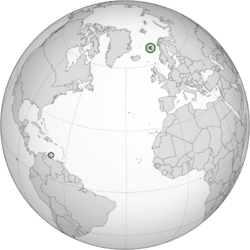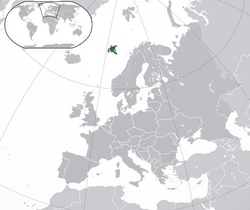Saint Scarlett
This article is incomplete because it is pending further input from participants, or it is a work-in-progress by one author. Please comment on this article's talk page to share your input, comments and questions. Note: To contribute to this article, you may need to seek help from the author(s) of this page. |
The Haugen Matriarchy of Saint Scarlett Haugen Matriarki av Sankt Skarlagen (Norwegian) | |
|---|---|
| Motto: "Til en Lys Fremtid" ("To a Bright Future") | |
| Anthem: "Svanesjøen" ("Swan Lake") | |
 Saint Scarlett on the Globe | |
 Saint Scarlett in Europe | |
| Capital and largest city | Rubin |
| Official languages | |
| Recognised regional languages | |
| Demonym(s) | Skarlagen |
| Government | Unitary Parliamentary Constitutional Matriarchy |
• President | Misty Rygg |
• Vice President | Catherine Harper |
| Legislature | Parliament |
| The House of Scarlett | |
| Medlemsmøte (Members’ Gathering) | |
| Independence from Norway | |
• Independence Declared | 2 May 1985 |
• War of Independence Won | 31 October 1987 |
• Admission to the WA | 1 May 1989 |
• Constitutional Matriarchy | 9 July 2019 |
| Population | |
• 2023 estimate | 2,478,000 |
• Density | 147/km2 (380.7/sq mi) |
| GDP (nominal) | 2023 estimate |
• Total | |
• Per capita | |
| Gini (2023) | low |
| HDI (2023) | very high |
| Currency | Vix (℣) (SKV) |
| Date format | dd-mm-yy |
| Driving side | left |
Saint Scarlett, officially the Haugen Matriarchy of Saint Scarlett (Norwegian: Haugen Matriarki av Sankt Skarlagen), is an island nation with territories in the Norwegian and Caribbean Seas. It lies close to the coast of Norway. St Scarlett covers 26,236 square kilometers and has has an estimated population of 2,478,000. St Scarlett is comprised of 6 regions and 1 overseas territory, St Lyra (formerly Bonaire) in the Caribbean sea, across a total of 9 major islands, with the largest being Scarlett Island.
Following a long period of dictatorship and isolation St Scarlett has finally begun opening itself up to the world and proving its citizens with many new civil rights, such as male suffrage in 2018. The nation recently joined NATO, which boosted its foreign relations massively. St Scarlett has the strongest ties to Laver Island, Norway, the United Kingdom, Chile-Venezuela and Ireland and has free trade agreements with all of them. A large number of people from these countries live in St Scarlett and many Skarlagens live in the respective nations. Scarlett’s strongest relationship however is with Laver Island a nation that is tied culturally and politically to St Scarlett, the two countries established a strong treaty with one another.
Saint Scarlett is a member of the World Assembly, Commonwealth of Nations and NATO.
Etymology
Saint Scarlett is named for its patron saint, Scarlett Espendottir, who spent many years on the islands preaching God's word and performing alleged miracles before being martyred in the capital city of Rubin which was little more than a village at the time. Saint Scarlett, along with Saint Lucia is one of only two countries in the world named after a historical female figure.
While in English the nation is named purely for its patron saint, its native Norwegian name Sankt Skarlagen, comes from the Norwegian name for the colour scarlet, 'skarlagen'. While in modern Saint Scarlett this name does indeed refer to Espendottir, known as 'Sankt Scarlett' in Norwegian, the incorrect word remains as a part of St Scarlett's history under Norwegian rule. After Espendottir was martyred in the nation the natives began to reject the original Norwegian name of 'Revøyer' ('Fox Islands') in favour of the name 'Scarlett Øyer' ('Scarlett Islands'). Norwegian politicians did not want rebellions in the region and rejected this name, renaming the islands Skarlagen Øyer in response, in what is seen as a snide attempt to give the inhabitants what they requested but in a way that completely invalidated their claims and disrespected their patron saint. While there have been discussions on updating the Norwegian name of the country to 'Sankt Scarlett' and many citizens already refer to the nation as Sankt Scarlett even when speaking Norwegian, most citizens accept it as a quirk of the nation, having been used even by the Catholics since the 1700s, and something that has been reclaimed for the patron saint and her followers and as a result it is often looked upon with fondness.
The Haugen part of the country's official name comes from Astrid Haugen who created the Republic of St Scarlett when she led a coup against the Matriarchal Council in May of 2018. The nation was reclassified as a Haugen Matriarchy when the two governments combined to form the current system of a Constitutional Matriarchy.
The standard way to refer to a citizen of St Scarlett is as a "Skarlagen", a name which is identical to the country’s Norwegian name.

